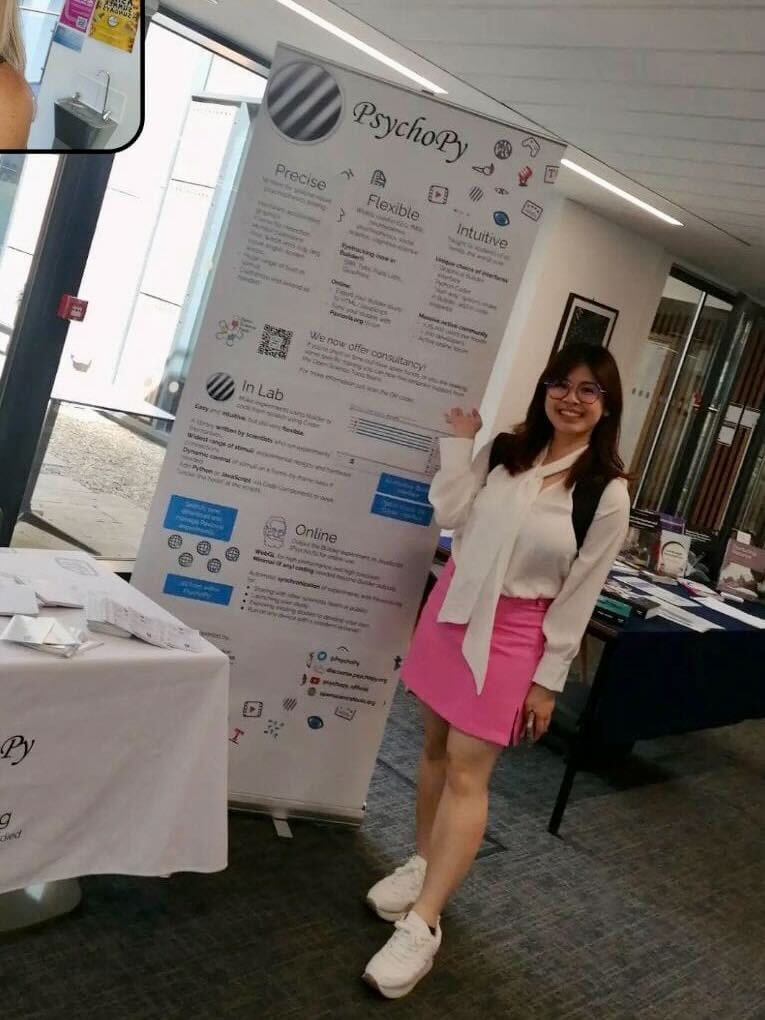Perspective story: Sue Lynn Mah
Origin story
I was first introduced to PsychoPy when I did my undergrad in the University of Nottingham Malaysia Campus. I believe it was the second week of lab practicals and we were already taught how to build our own PsychoPy task - it was of course a Stroop task. It then evolved into other cognitive tasks such as the Navon task, mental rotation etc. One of the assessments for my lab practicals was to build a psychopy task on the spot! To say I was thrown into the deep end would not be an exaggeration 😂 Fast forward to second year, I was building all my PsychoPy tasks pretty much independently and dipped my toes in Python programming for my final year project because editable textboxes were not a thing yet.
After graduating, I started my PhD in Psychology at the University of Nottingham UK. This is when I really started getting into more advanced coding concepts. I attended the in-person PsychoPy workshop back when it was all taught from Coder View which made me appreciate having a Builder View even more! Although, having said that, being exposed to the “under the hood” code made the next phase of my PsychoPy journey slightly easier because a little thing called Covid happened.
Intermediate user of PsychoPy?
When the pandemic hit, all of my tasks were already built and ready for data collection but we could not collect any in-person data which meant that I had to figure out how to get my experiments to Pavlovia so that I could collect data online. Pavlovia had just been introduced for a couple of months so features like the slider was not available just yet. My thoughts back then was “Well I’ll just build my own slider then!”. And attending the in-person workshop back in my first year was really helpful because the idea of coding something from scratch didn’t seem that scary. And with some guidance from the forum, I eventually got a rudimentary slider working and my data collection was back on track!
I then started helping my friends to build/debug their tasks which increased my confidence as a PsychoPy user which eventually led to me helping out externally researchers and was also asked to support one of the first online PsychoPy workshops. One of my Pavlovia tasks was also shared externally and was used in study that was later published.
The next phase of my PsychoPy/Pavlovia journey…
Towards the end of my PhD, I was employed by Open Science Tools and began my life as a Science Officer helping researchers around the world and from various fields create bespoked PsychoPy/Pavlovia tasks and lead workshops. This job sits between academia and industry so I was happy to still be able to keep a connection within the academic community. Here’s a picture of my attending the BPS Bristol conference!

This role has also allowed me to expand my knowledge of Python and Javascript which has led me to create some cool gamified tasks such as this BART task or this mathematical cognition task. Note: These tasks have been shared with permission.
As someone who’s background is in psychology, I would never have thought that I would be able to venture into the world of software development. At this point, I’m somewhat of a “super user” of PsychoPy/Pavlovia so when I’m not doing consultancy work, I’m creating demos on the forum and Pavlovia as well as writing documentation for the software. My time as a Science Officer has now come to an end and I will be switching my focus onto more research-based roles within academia. This does not mean that my PsychoPy/Pavlovia journey is ending though. I foresee myself creating more gamified-tasks when inspiration strikes, my friends randomly messaging me questions on why their task is not working and occasionally go forum-surfing when I have some spare time to kill 😄
